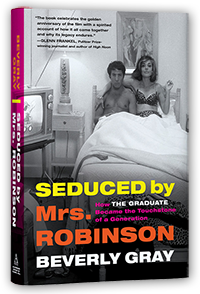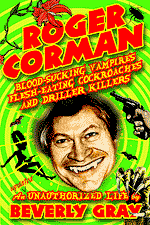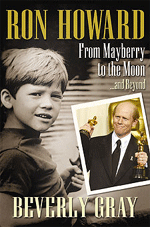Circa
1954, when he first started producing and directing movies, Roger Corman
realized that he was lacking in a few important departments. He had energy, he
had talent, but he didn’t have a ready source of funding. Nor did he have a
large-scale distribution network. That’s why he turned to the American
Releasing Corporation, which soon changed its name to American International
Pictures. AIP, taking advantage of a Supreme Court anti-trust ruling that stripped
the big Hollywood studios of their power over motion picture theatre chains,
had started supplying movies to drive-ins and smaller theatres. AIP films were
made fast and cheap, and were geared to teenage audiences. Joe Dante has clarified
for me the key to AIP’s success: “The whole thrust of these cheap movies was
that they were movies your parents wouldn’t want you to see.”
End
of history lesson. Anyway, the founders of AIP were a film exhibitor, James
Nicholson, and an entertainment lawyer, Samuel Z. Arkoff. Of the two, Roger
Corman always figured that Jim Nicholson was the more creative, the more
attuned to cinema aesthetics. But, at age 56, Jim was becoming increasingly
conservative at the same time that Roger, ten years younger, was flirting with Sixties-style
radicalism. Their conflict came to a head when Roger shot a film exploring the pleasures
and pains of LSD. Stepping in, Nicholson
insisted on adding to The Trip an opening
disclaimer that warned audiences about the dangers of drug use. Nicholson also
re-edited the final shot of the film, putting a jagged crack over the image of
Fonda’s face, thus undoing Corman’s own non-judgmental ending by suggesting a
shattered life. Roger was furious. Soon, with the production of Gas-s-s-s! (1970), his relationship with
his longtime backers at American International Pictures would be strained
beyond repair.
The
great irony is that the screenplay credit for The Trip went to another Nicholson, the irrepressible Jack. Years
later, Jack Nicholson told me that “my first meeting with Roger Corman was in
Jeff Corey’s acting class, in which we were both very shy and stumbling
neophytes. He was serious, I was serious, and we survived.” His first-ever
film, at age 21, was The Cry Baby Killer,
which Roger produced but did not direct. At least one early Cormanite, feeling
Jack was handicapped by an unfortunate speaking voice, urged him to quit acting
and go into real estate. Nonetheless, he was soon a Corman regular. Most
famously he played the masochist at the dentist’s office in Little Shop of Horrors. But in several
of Roger’s costume dramas, he was the earnest (and skinny) young juvenile. Soon
after writing The Trip, in which
Peter Fonda survives a series of hallucinogenic fantasy sequences, Jack accepted
a featured role in Fonda and Dennis Hopper’s landmark Sixties sex-drugs-and-rock
‘n’ roll flick, Easy Rider . . . and a star was born.
The
climax of Alex Stapleton’s recent documentary, Corman's World: Exploits of a Hollywood Rebel,
is an interview with Jack Nicholson. Suddenly, he dissolves into tears as he
remembers the way Roger Corman jumpstarted his unlikely – and very brilliant –
career.








It's a golden moment in a terrific documentary - as Corman's World is a nearly perfect film experience - I think you know what's missing - and missed - in its running time. I always loved Nicholson'd and Arkoff's business model and formula. I also enjoyed seeing Jack Nicholson's early film work. A doubly good dose of anecdotery today, Ms. G!
ReplyDeleteI'm sure Alex Stapleton would be delighted to read your praise of her Corman documentary, Mr. E.
ReplyDeleteMovies. Such a collaborative art. They work so much better when everyone can agree.
ReplyDeleteInteresting story.
Hi Liz, Welcome to Movieland! You're right about the importance of collaboration, but it's hard to come by in the movie biz. Do you speak from experience?
ReplyDeleteVery interesting. Jack has been around a long time.
ReplyDeleteA-Z
Thanks, Sandy. Seems as though you're a travel expert, which has made me think of some of the wonderful (and some of the sleazy) hotels that exist in Movieland. Chateau Marmont, anyone?
ReplyDelete